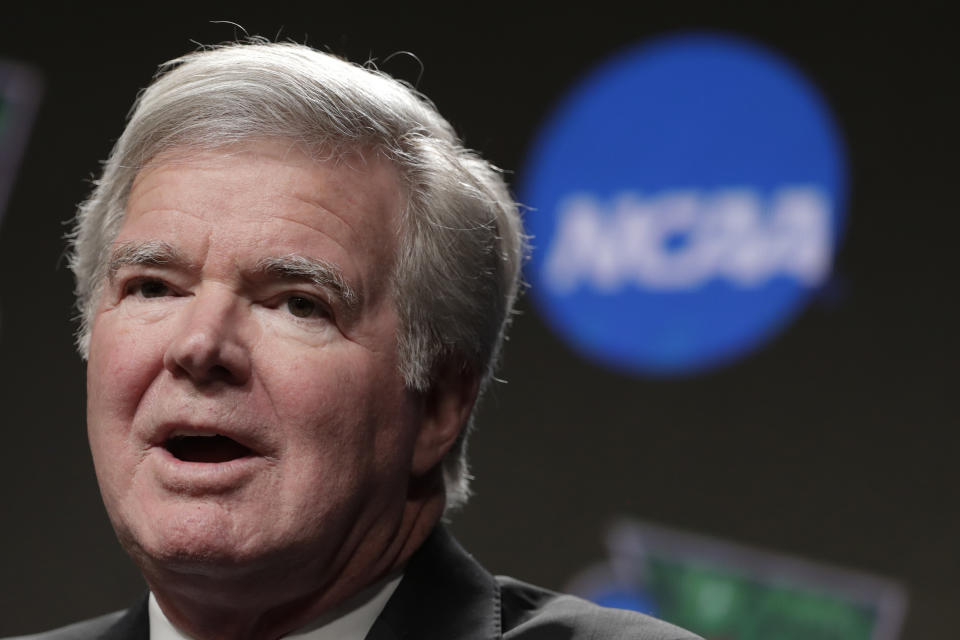How 'rise of social media' helped change NCAA's stance on name, image and likeness payments
The NCAA is finally relenting and will begin to allow its athletes to pursue business deals for the use of their names, images and likenesses.
It was the right thing to do. Some of the NCAA’s most senior leaders have said so themselves.
After decades of claiming that college athletes being paid in any way would jeopardize its most precious tenet (read: business model) of amateurism, the NCAA’s Board of Governors on Wednesday officially endorsed a broad spectrum of recommendations to allow college athletes to be compensated for things like product endorsements, autographs and personal appearances.
It was already blatantly apparent to observers, but the recommendations made by an NCAA working group show that legislation in states like California and Colorado put the NCAA’s feet to the fire on the name, image and likeness issue.
If individual states continue passing NIL legislation for college athletes in their respective states, the NCAA knows that will make its governance on the issue irrelevant. Or as the working group put it, the proposed legislation “poses a significant potential challenge to the [NCAA]'s continuing ability to manage its affairs on a national level.”
But don’t overlook the role that social media had in helping notoriously behind-the-times NCAA leaders see the light on this issue.

‘Rise of social media’ played big role in new NIL rules
When you flip through the 31-page document the NCAA made public on Wednesday, it is pretty clear that the “rise of social media” helped NCAA officials wrap their heads around what was once considered unthinkable in their circles.
If any average student on campus has the opportunity to make money as a so-called social media “influencer,” then why should an athlete be stopped from doing the same?
“The rise of social media and other digital distribution and monetization platforms has dramatically increased the opportunities for college students to make commercial use of their NIL,” the executive summary of the NCAA working group’s recommendations says.
“Current divisional rules on this subject were drafted long before most of these opportunities existed, and those rules can prevent student-athletes from engaging in NIL-related activities that their non-athlete peers on campus frequently pursue. Consistent with the Board's direction that student-athletes should be treated the same as students in general, unless a compelling reason to differentiate exists, the working group concluded that divisional rules on student-athlete NIL should be modernized to account for this new media and promotional landscape.”
Football and men’s basketball are the money makers in college sports, and athletes in those sports will certainly be presented with an array of opportunities once these rules formally are adopted next year. But it goes beyond those two sports. Think of athletes in Olympic sports like Stanford swimmer Katie Ledecky, a five-time gold medal winner, or UCLA gymnast Katelyn Ohashi, whose perfect 10.0 routine went viral on social media last year. They would have attracted an array of lucrative marketing opportunities while remaining in school.
NCAA officials are now publicly grasping what has long been obvious to many.
“The NCAA's current rules tend to prohibit student-athletes from engaging in these activities in a blanket manner,” the working group’s report reads. “The working group recommends that the rules be thoroughly reworked to address directly the modern NIL environment. The working group also believes that the rules should generally permit student-athletes to pursue the same kind of promotional opportunities that are available to other students.”
Just 2 years ago, UCF kicker chose YouTube over college football
A recent example of NCAA rules impacting a student-athlete’s ability to be compensated arose at UCF in 2017. Donald De La Haye was a kicker for the Knights with a thriving YouTube channel that, in part, documented his life as a college athlete.
While playing for UCF, De La Haye was making money from the advertisements that YouTube placed on his videos. That monetization caught the attention of UCF compliance, which ultimately determined he was violating NCAA rules. UCF submitted a waiver to the NCAA. The NCAA granted the waiver and said De La Haye could make money from his videos — but only if the videos “not did not reference his status as a student-athlete or depict his football skill or ability.”
De La Haye declined to abide by those stipulations, choosing YouTube over college football, and was ruled ineligible. He also lost his athletic scholarship in the process. Later, he sued UCF and the two sides reached a settlement.
Had De La Haye come along after these rules went into effect, he would have kept his scholarship and been able to keep making videos showing his life as a college athlete. The NCAA working group’s recommendations specifically mention an athlete having a YouTube channel:
It could be permissible for a student-athlete to post content to a YouTube channel (e.g., day-in-the-life) and be compensated for endorsement of a particular product (e.g., product placement in the videos) provided that University A did not aid in the production of the content and no university marks are used.
When De La Haye’s situation first arose in June 2017, his YouTube channel had around 50,000 subscribers. As of this writing, his subscriber count is at 2.48 million with more than 350 million total views.
Now, in an ironic twist, De La Haye may have a new source of revenue in the future thanks to the NCAA.
Bout to recruit some college athletes and help them with YouTube
— Donald (@Deestroying) April 29, 2020
More from Yahoo Sports:
